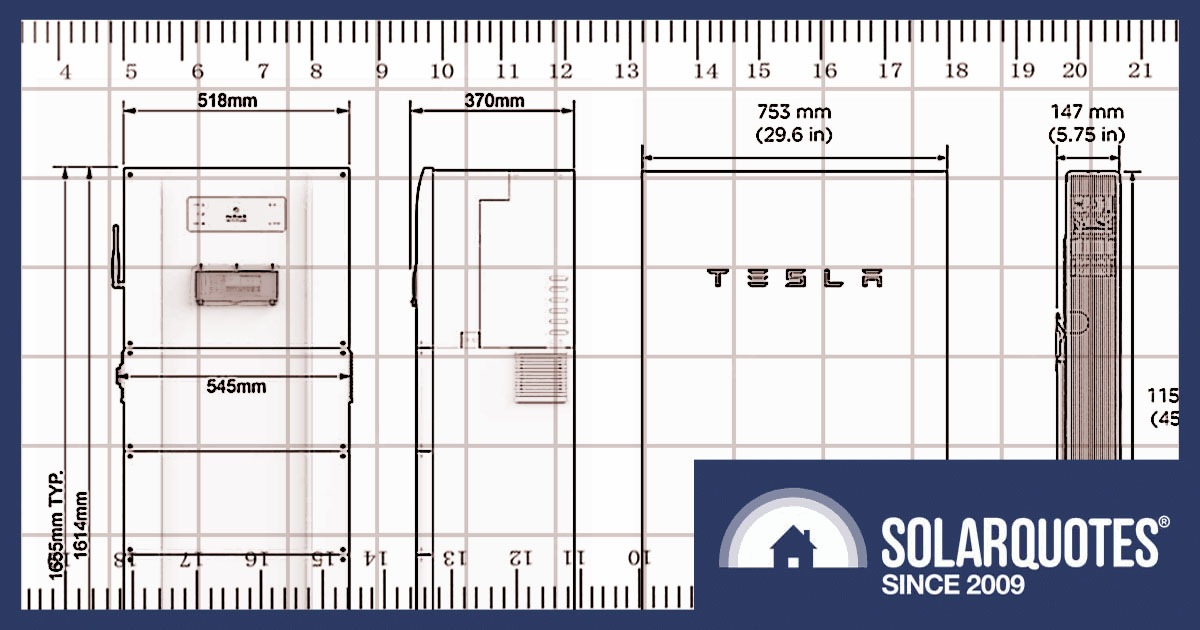
While we often talk about solar battery capacity, let’s take a detour and explore their physical dimensions – yes, their actual size. It may seem like an odd question to some, but understanding the dimensions can make all the difference if you’re short on space.
In this article, we’ll also look at how dimensions relate to energy density. That’s bang for your buck for a given size, not dollars. How much energy can they pack into a home battery right now, and how small will they be in the future? And perhaps more importantly, does it matter?
How Big Are Solar Batteries?
There are many battery types, varying capacities, and different form factors. We’ll have to narrow our focus to a particular capacity range and application to give a meaningful answer.
For this article, let’s look at ten popular grid-tied, non-all-in-one lithium-ion batteries with a usable capacity range between approximately 10 kWh and 14 kWh. That way, we should be able to make a fair comparison to see how a few different models stack up against each other in terms of their space requirements and energy density.
Sizing Up The Batteries
The batteries below have been selected from the SolarQuotes Battery Comparison Table. First, listed from smallest through to largest capacity. Note that some of these are modular, where the sum of all battery modules equals the whole output. The Enphase IQ is not modular but listed twice (2 x 5 kWh) to bring the capacity in line with others being compared.
Further in the comparison tables, there is a column for BMS (Battery Management System). Many batteries have the BMS built in so it’s already accounted for in the measurement. However, two batteries in the comparison have an external BMS, which should be counted. Note that BMS in this instance is used as a generic term. Some manufacturers have different names for their BMS such as ‘gateway’ or ‘controller’ etc1.
| Battery | Useable Capacity |
|---|---|
| SolarEdge Energy Bank | 9.7 kWh |
| Enphase IQ Battery 5P (x2) | 10 kWh |
| Huawei Luna 10 kWh | 10 kWh |
| Jinko Suntank 12.8 kWh | 11.5 kWh |
| LG Chem RESU 12 | 11.7 kWh |
| Redback Smart Battery SB14200 | 12.8 kWh |
| Sungrow SBR HV 12.8 kWh | 12.8 kWh |
| GoodWe Lynx Home F Series LXF13.1-H | 13.1 kWh |
| Tesla Powerwall 2 | 13.5 kWh |
| BYD Battery Box Premium HVM 13.8 | 13.8 kWh |
Depth
If you have limited floor space or prefer a battery that doesn’t protrude too much, the following dimensions will interest you. Here are the same batteries, with depths listed from shallowest to deepest.
| Battery | Battery Depth | BMS Depth |
|---|---|---|
| Tesla Powerwall 2 | 147 mm | 149 mm |
| Huawei Luna 10 kWh | 150 mm | N/A |
| Enphase IQ Battery 5P (x2) | 188 mm | 158 mm |
| LG Chem RESU 12 | 227 mm | N/A |
| SolarEdge Energy Bank | 250 mm | N/A |
| Jinko Suntank 12.8 kWh | 260 mm | N/A |
| BYD Battery Box Premium HVM 13.8 | 298 mm | N/A |
| Sungrow SBR HV 12.8 kWh | 330 mm | N/A |
| Redback Smart Battery SB14200 | 370 mm | N/A |
| GoodWe Lynx Home F Series LXF13.1-H | 380 mm | N/A |
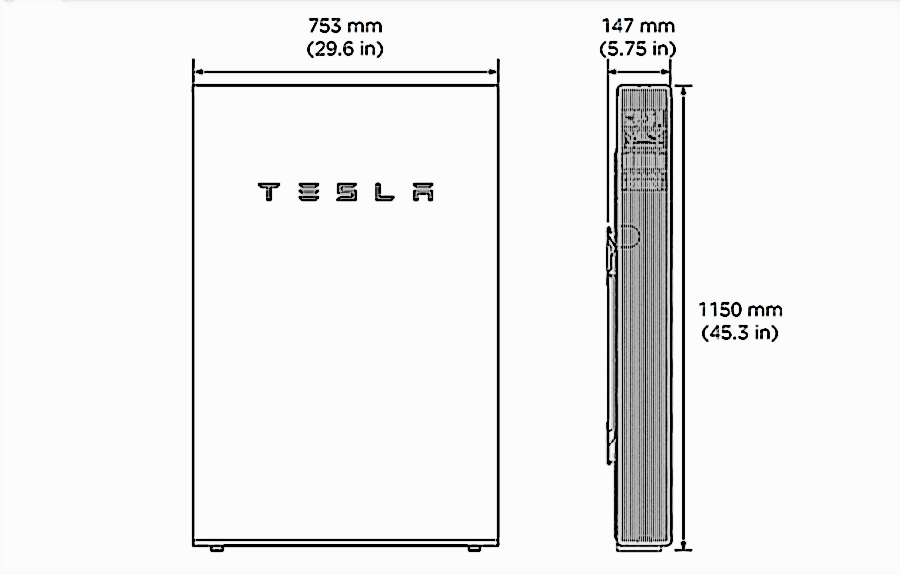
The Tesla Powerwall 2 dimensions – the shallowest battery in this comparison.
Wall Area (Height x Width)
Maybe it’s wall space you’re short on. Plenty of other things might compete for wall space, such as storage and shelving, doors and windows, and existing wall-mounted appliances. In the following table, the batteries are now listed in order from smallest to largest two-dimensional area on the vertical plane (wall).
Also – Australian battery location regulations (aka Australian Standard AS5139) prohibit batteries within 600mm of a window or ‘non-associated’ equipment – substantially reducing usable wall space.
The Tesla Powerwall should be highlighted for its ability to use wall space efficiently. Up to three Powerwalls can be stacked together, positioned perpendicular to the wall, allowing for a total storage capacity of 40.5 kWh using no more wall area than a single Powerwall.
| Battery | Battery Area | BMS Area |
|---|---|---|
| LG Chem RESU 12 | 0.28 m2 | N/A |
| Sungrow SBR HV 12.8 kWh | 0.42 m2 | N/A |
| GoodWe Lynx Home F Series LXF13.1-H | 0.55 m2 | N/A |
| Jinko Suntank 12.8 kWh | 0.59 m2 | N/A |
| Huawei Luna 10 kWh | 0.64 m2 | N/A |
| BYD Battery Box Premium HVM 13.8 | 0.83 m2 | N/A |
| Redback Smart Battery SB14200 | 0.86 m2 | N/A |
| Tesla Powerwall 2 | 0.87 m2 | 0.27 m2 |
| SolarEdge Energy Bank | 0.93 m2 | N/A |
| Enphase IQ Battery 5P (x2) | 1.78 m2 | 0.38 m2 |
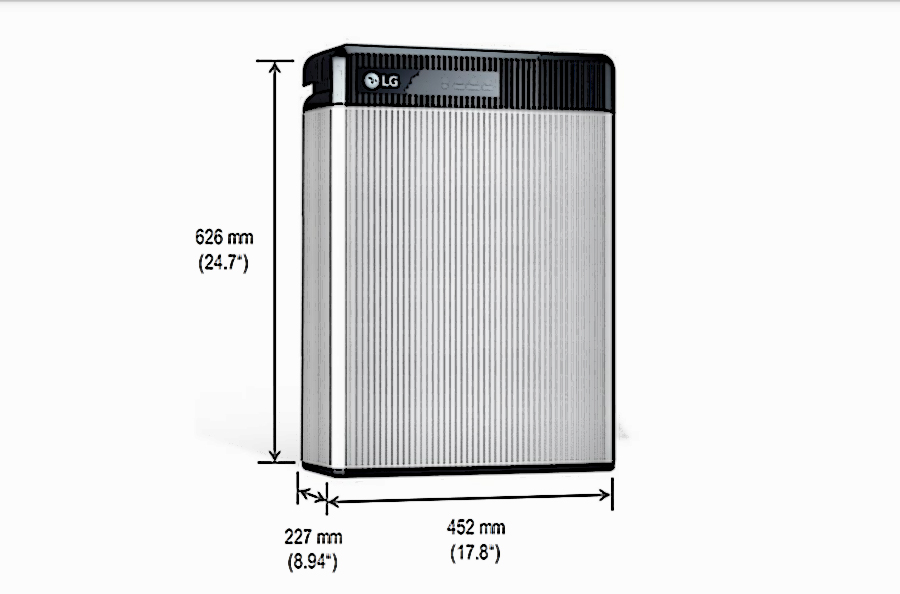
The LG Chem Resu 12 doesn’t take up much wall space. I wonder if that’s the whole story?
Volume
To get a true indication of how much space a battery will take up, we could look at the overall volume by combining the above tables. (Volume (m3) = height x width x depth). Here they are listed from smallest to largest, measured in cubic metres.
| Battery | Battery Volume | BMS Volume |
|---|---|---|
| LG Chem RESU 12 | 0.07 m3 | N/A |
| Huawei Luna 10 kWh | 0.10 m3 | N/A |
| Tesla Powerwall 2 | 0.13 m3 | 0.04 m3 |
| Sungrow SBR HV 12.8 kWh | 0.14 m3 | N/A |
| Jinko Suntank 12.8 kWh | 0.15 m3 | N/A |
| Enphase IQ Battery 5P (x2) | 0.20 m3 | 0.06 m3 |
| GoodWe Lynx Home F Series LXF13.1-H | 0.21 m3 | N/A |
| SolarEdge Energy Bank | 0.23 m3 | N/A |
| BYD Battery Box Premium HVM 13.8 | 0.25 m3 | N/A |
| Redback Smart Battery SB14200 | 0.32 m3 | N/A |
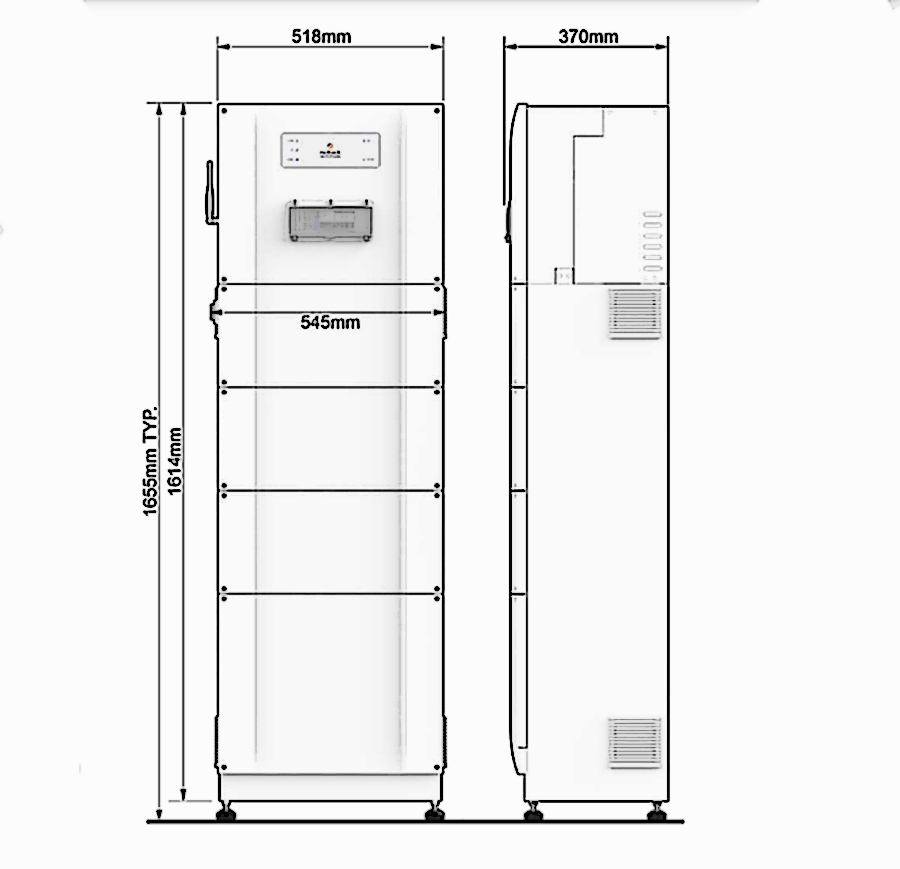
At a third of a cubic metre, the Redback Smart Battery SB14200 sure takes up a lot of space!
Dimensions
And here is the same table as above, this time with the actual dimensions given, rather than the three-dimensional volume. A clearer picture of the physical battery size should now be emerging. Knowing these dimensions can help you visualize the likely aesthetics, ensuring the battery doesn’t overwhelm the space.
| Battery | Battery Dimensions H x W x D | BMS Dimensions H x W x D |
|---|---|---|
| LG Chem RESU 12 | 626 x 452 x 227 mm | N/A |
| Huawei Luna 10 kWh | 960 x 670 x 150 mm | N/A |
| Tesla Powerwall 2 | 1150 x 753 x 147 mm | 660 x 411 x 149 mm |
| SunGrow SBR HV 12.8 kWh | 675 x 625 x 330 mm | N/A |
| Jinko Suntank 12.8 kWh | 909 x 650 x 250 mm | N/A |
| Enphase IQ Battery 5P (x2) | 980 x 550 x 188 mm (x2) | 760 x 500 x 158 mm |
| Goodwe Lynx Home F Series LXF13.1-H | 920 x 600 x 380 mm | N/A |
| SolarEdge Energy Bank | 1179 x 790 x 250 mm | N/A |
| BYD Battery Box Premium HVM 13.8 | 1411 x 585 x 298 mm | N/A |
| Redback Smart Battery SB14200 | 1655 x 518 x 370 mm | N/A |
Energy Density (Battery + BMS)
Energy density in a battery refers to the total amount of stored energy available relative to the volume it’s stored in. It’s sometimes confused with another important metric called specific energy, which is the total amount of stored energy available relative to its mass (kg).
Energy density can be expressed in several ways. The following table uses the metric system to keep things in step with the previous comparisons, showing energy density as kilowatt-hours available per cubic metre of storage. Battery plus BMS are included.
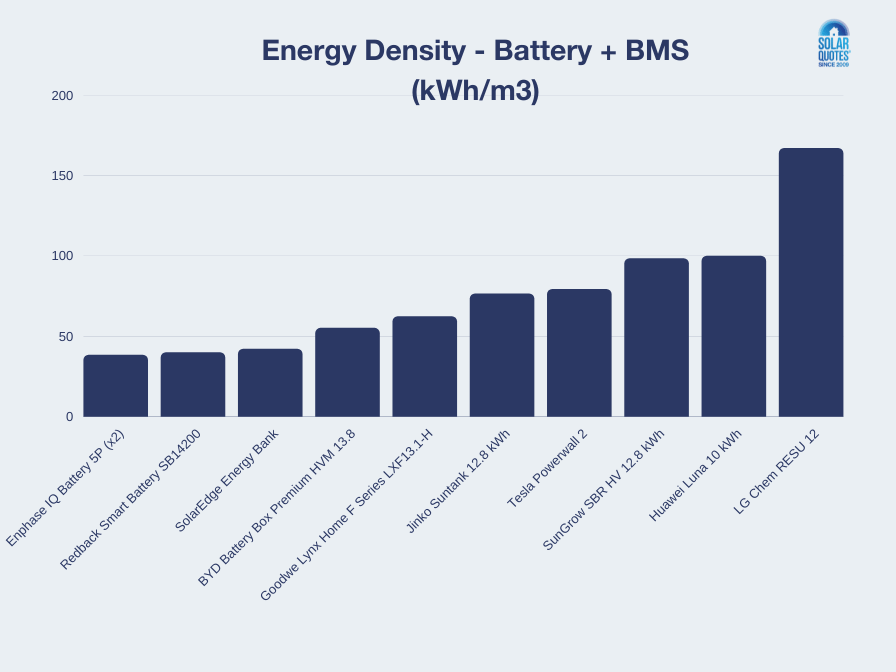
The taller the bar, the more compact the battery.
| Battery | Battery + BMS Energy Density |
|---|---|
| Enphase IQ Battery 5P (x2) | 38.5 kWh/m3 |
| Redback Smart Battery SB14200 | 40 kWh/m3 |
| SolarEdge Energy Bank | 42.2 kWh/m3 |
| BYD Battery Box Premium HVM 13.8 | 55.2 kWh/m3 |
| GoodWe Lynx Home F Series LXF13.1-H | 62.4 kWh/m3 |
| Jinko Suntank 12.8 kWh | 76.6 kWh/m3 |
| Tesla Powerwall 2 | 79.4 kWh/m3 |
| Sungrow SBR HV 12.8 kWh | 98.5 kWh/m3 |
| Huawei Luna 10 kWh | 100 kWh/m3 |
| LG Chem RESU 12 | 167 kWh/m3 |
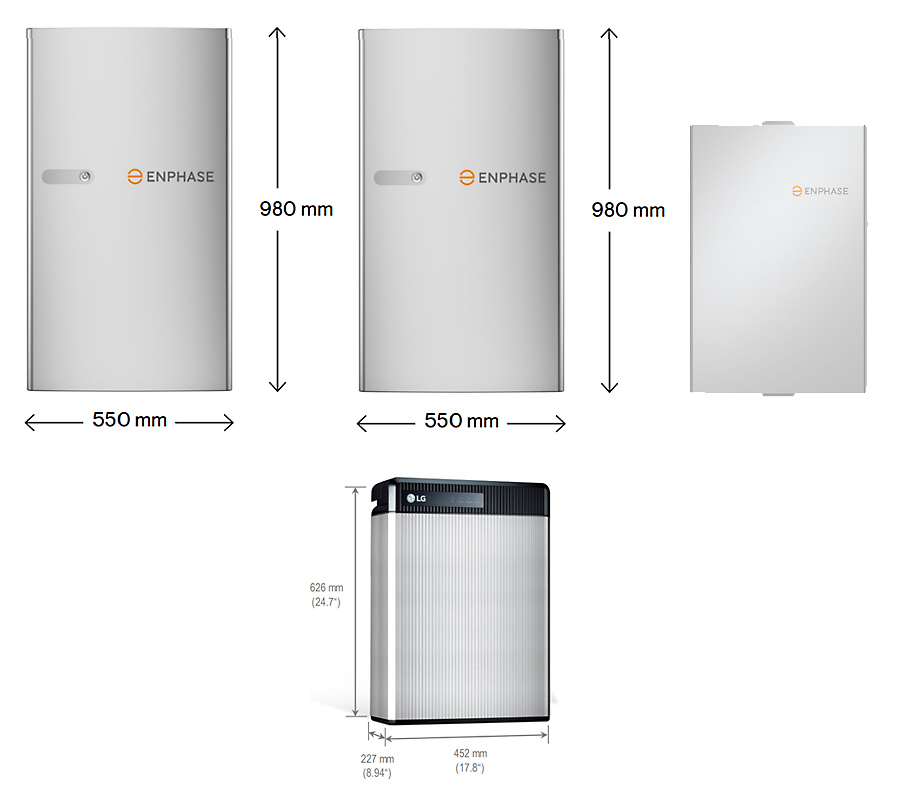
Top: The lowest energy density battery/s in our comparison – Enphase IQ Battery 5P (x2) + BMS (10 kWh). Bottom: The highest energy density model in our comparison – LG Chem RESU 12 (11.7 kWh). Drawn to scale!
The New Enphase Battery Is Huge
Enphase is the loser in this battery energy density competition. The company recently released a publicity shot that will give you a feel for how big their 10 kWh battery is. I’m not sure how many Australians can fit even one of these in their homes.
How does the new IQ Battery 10T differ from the IQ Battery 10?#SolarSurge's Joe Ordia talks with Enphase's Mohammad Alkuran about the IQ Battery 10T's sleeker design and mechanical improvements, in a hands-on review at #Enphase HQ in Fremont, CA: https://t.co/VsZaMIIiYL pic.twitter.com/4bSAfFMQ9Q
— Enphase Energy (@Enphase) August 10, 2023
Design Priorities
There is a wild variation in the energy densities of batteries studied. I had to check my figures more than twice, but I’m confident they’re close enough to get the point across. In this case, the point is that energy density and physical size are not necessarily at the top of every manufacturer’s list of priorities.
Other factors a manufacturer would consider, and may play into the design parameters are: battery chemistry, form factor, safety, market demands, cost, economies of scale, and available technology.
Does Battery Energy Density Matter?
Just in case you’re wondering, energy density does NOT indicate the quality of a battery, so this comparison isn’t about which is the best battery. There are other points to consider such as cycle life, efficiency, safety, performance at different temperatures, warranty, environmental impact, and so on.
A high energy density can be both a plus and a potential challenge depending on the specific use case and requirements. Here’s a breakdown of the advantages and potential drawbacks of a high energy density in a battery:
Advantages
✅ Compact Size: High energy density batteries can store a significant amount of energy in a smaller physical space, making them suitable for applications with limited available space. So, for home energy storage systems or grid applications, high-energy-density batteries can maximize the amount of energy stored in a given physical footprint.
Challenges
❌ Thermal Management: High energy density batteries tend to generate more heat during charge and discharge cycles. Ensuring proper thermal management becomes crucial to prevent overheating and safety risks.
❌ Cycle Life: Often, high energy density batteries may have a trade-off with cycle life. They might experience more rapid degradation over a certain number of cycles compared to lower energy-density batteries.
❌ Safety Concerns: Some high energy density chemistries can be more prone to safety risks, including thermal runaway and fire hazards, if not properly designed and managed.
(You can read what you like into these energy density figures given for each particular battery, but from where I stand there may or may not be one that pushes the envelope a bit far. Just sayin’.)
How Big Will Home Batteries Be In The Future?
Today, lithium-ion provides the highest level of energy density in a home solar battery. Last time I looked into my crystal ball, promises were being made about new technology, which could be up to four times smaller than current lithium-ion batteries. That’s four times the energy density of today!
Significant research is being conducted as we speak on many alternatives to lithium-ion. If any of these go into production, they will most likely initially target applications such as electric vehicles and aviation, where weight and size are crucial. When, or if, any of them get to the price point suitable for the home battery market is anybody’s guess. Here are just a few of them:
Solid-State Batteries: use solid electrolytes instead of liquid electrolytes, offering several advantages, including improved safety, higher energy density, and potentially longer cycle life.
Lithium-Sulfur Batteries: have the potential to offer higher energy density compared to traditional lithium-ion and could be attractive for home solar storage.
Metal-Air Batteries: such as lithium-air batteries, have the potential to achieve very high energy densities by using oxygen from the air as a reactant. These batteries could be relevant for residential solar energy storage due to their high capacity, but challenges related to efficiency and cycle life need to be addressed.
Recommendations For The Space-Conscious
For those who are particularly space-conscious, the following batteries stand out as strong options:
- Tesla Powerwall 2: With one of the shallowest depths, a reasonable wall area and an optional stacking kit, this battery can be expanded from the initial 13.5 kWh up to 40.5 kWh without requiring any more wall space than a single unit.
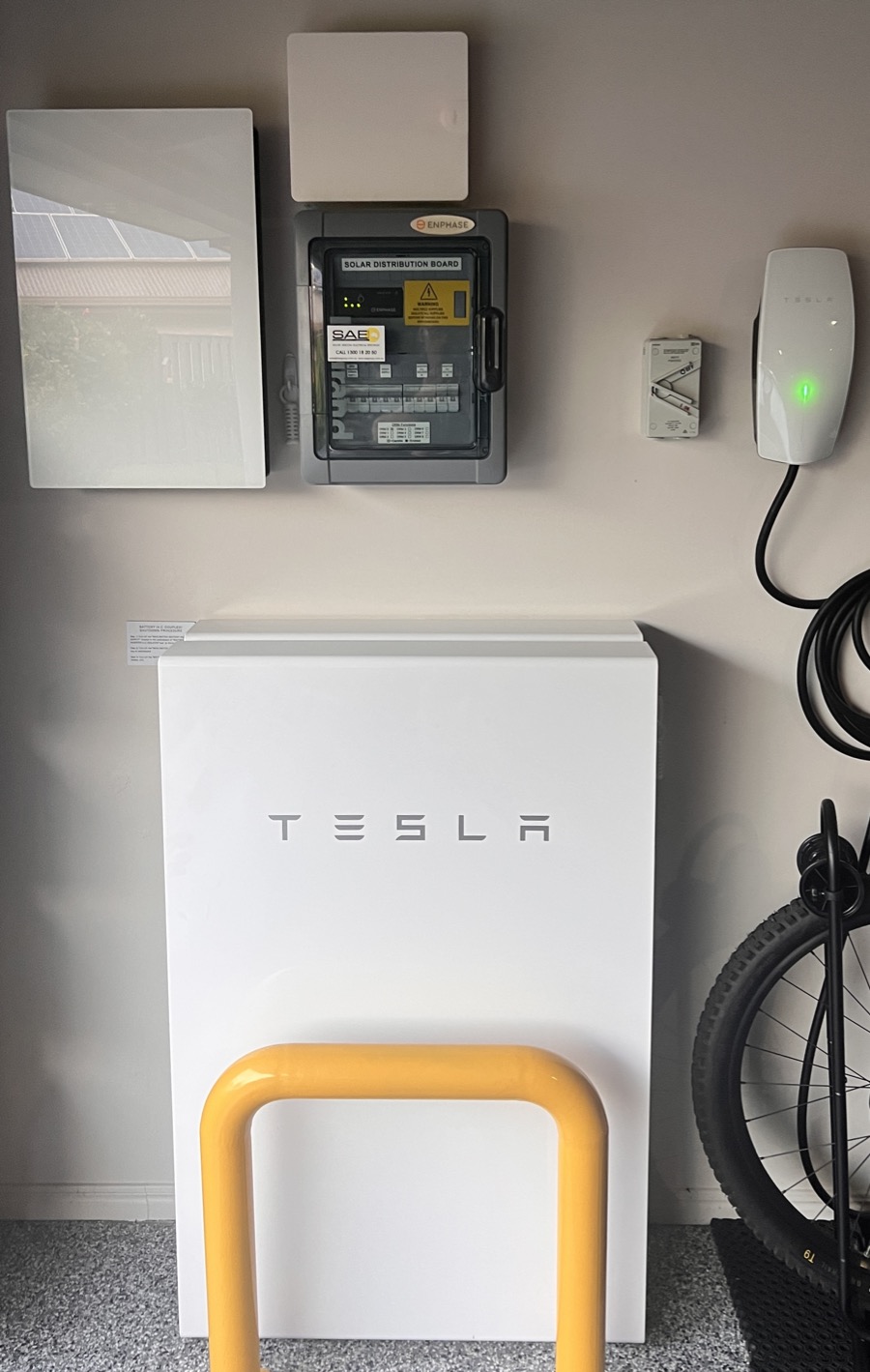
Two stacked Powerwalls totaling 27 kWh of energy storage, and the Tesla Gateway (top left). Installation: SAE
- Sungrow SBR HV: The stackable modules and high energy density allow up to 25.6 kWh of storage using no more floor area than a single 3.2 kWh module.
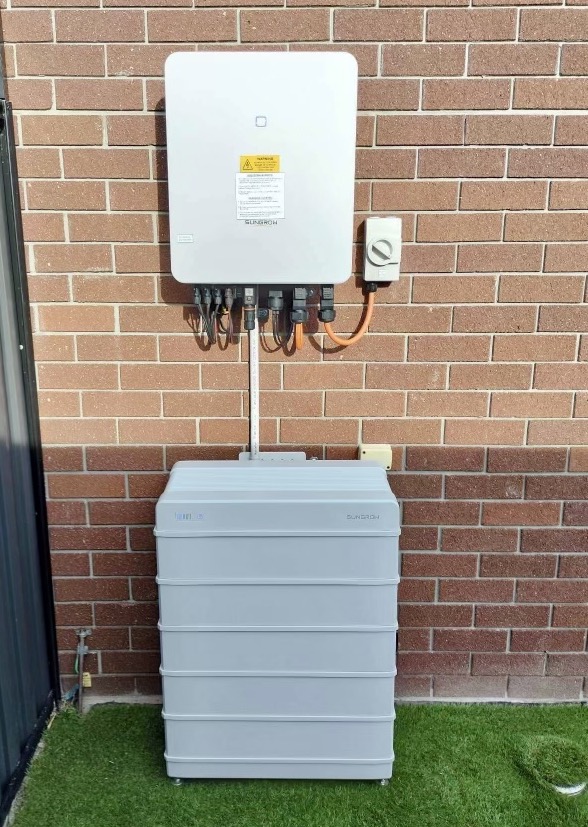
Five stacked 3.2 kWh Sungrow battery modules, totalling 16 kWh of energy storage. Installation: Solaire Connect
Energy density is not the sole measure of a battery’s quality. However, it will play a part as new technologies come online. My crystal ball needs a service, so I can’t tell you which of those technologies will prevail. But I do know one thing – they WILL prevail because, as we all know, new technology waits for nobody.
Footnotes
- I know, the Tesla Gateway is not technically a BMS ↩

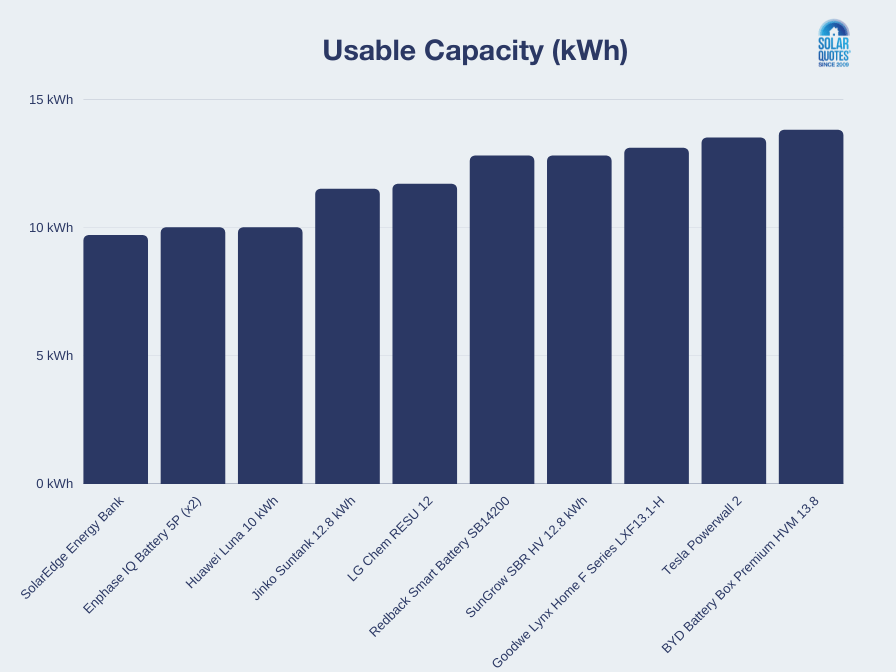
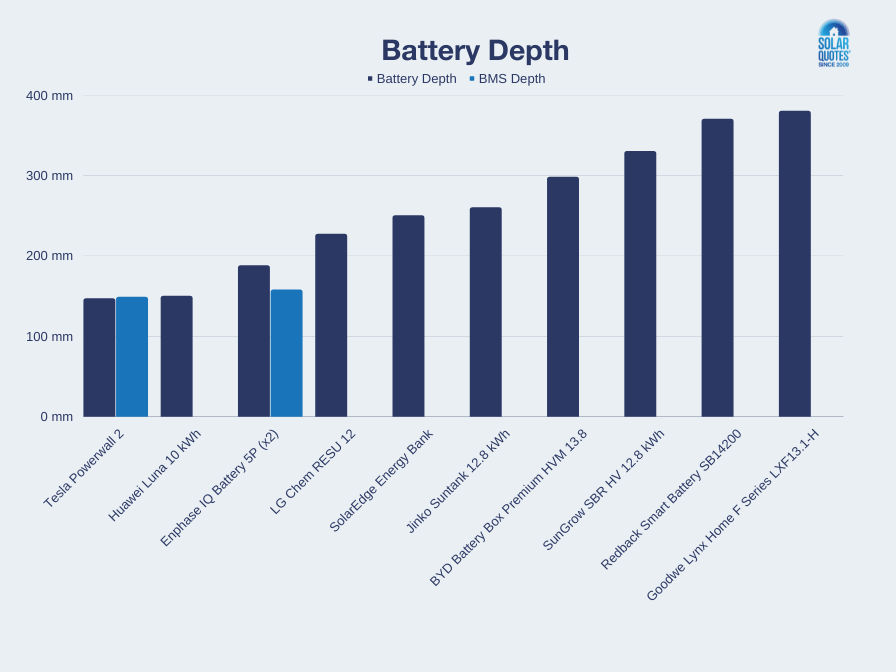
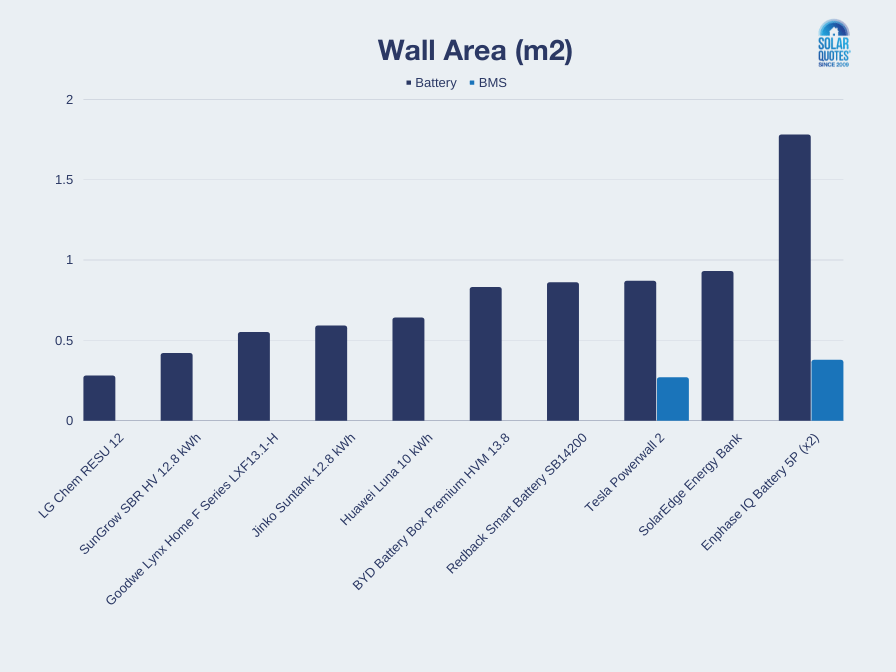
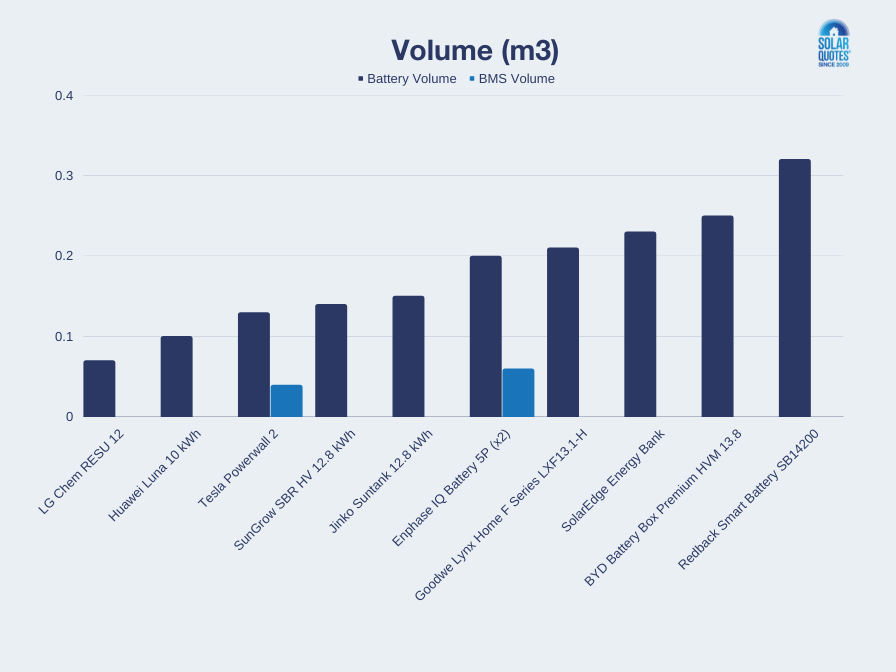
 RSS - Posts
RSS - Posts



I use Zenaji Lithium Titanate batteries. Their footprint is huge: each 1.93kWh battery is abt 150mmx1600mm, then you need the Charger inverter as well (I use Victron Multiplus 2, 5Kw). I have 6 batteries. Rural install so not worried abt space. We cycle them at least once a day.
I like these batteries because they are very fire-safe. I feel they are worth the approx 20% price premium.
Apparently the new Zenaji batteries will run with some hybrid inverters (48v battery packs in series).
The Zenajis are brilliant – a “wide mouthed frog” as my brother puts it. The high C rating allows opportunistic grabbing of high power levels, during gaps in predominant cloud cover. He has 20 kW of PV and 8 of the LTO batteries. Yesterday they were fully charged by 10 a.m., in the depths of winter, and he was exporting over 6 kW, consuming about the same. And the amazing cycle life removes all concerns about cycling them a couple of times per day.
What stops me from following suit is that he bought them for about $3300 each, but says they’re now about $4400 a piece. (The currently low A$ and stupid inflation don’t help much there. 🙁
He had just changed the charge limit from 8 kW to 12 kW, following an upgrade from 5 batteries to 8, the capacity of two Lynx busbar blue boxes. (What they call them escapes my memory.) The Victron DVCC s/w running on the Cerbo GX orchestrates the MPPTs and the two AC coupled inverters to all respect the new charging regime. It is a delightfully flexible system, with very easy configuration. That much I do plan to go with.
For fully off-grid, I’m eyeing an oversized bank of LiFePO₄ to both accept high charging power and reduce cycling to significantly below one per day, most of the time. Some ex-EV 48v modules would be ideal, but could bring with them unknown BMSs, making cell balance possibly unknown.
I’ve seen a YT clip of a large LiFePO₄ cell which emitted copious volumes of smoke, but no flames. Perhaps not as good as LTO, but fire safe, I think.
Presumably there is an energy density figure at which fan cooling becomes necessary or do they all have it?
Good question Matt. I couldn’t give you the definitive answer to ‘at what point active cooling is needed’, but there are several cooling methods. Some batteries are air cooled by fan, while others use liquid coolant pumped around the battery. Another battery – the LG Chem RESU 12, appears to be increasing the surface area by using small cooling fins/ridges on the outer case. If you dig deep into the spec sheets and documents for each individual battery I’m sure you would find the approach used by each manufacturer.
can solar batteries be installed outside the house , semi protected from the rain (to be near the solar panel inverter etc)
Yes – many batteries are rated for outdoor installation (like the Tesla Powerwall). Look for their IP rating to be IP55 or IP65. Ultimately they want to be under some kind of shelter instead of totally exposed to the elements.